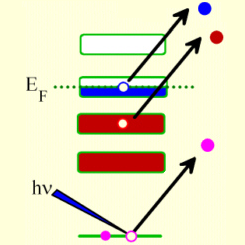Synchrotron radiation
Our group is involved in research activities at synchrotron radiation sources. Two experimental techniques mainly used from our group are indroduced briefly on this page.
Polarization-dependent x-ray absorption spectroscopy (XANES, NEXAFS)
In x-ray absorption spectroscopy, we measure the absorption of the x-rays due to electron excitations from occupied into unoccupied levels as a function of the energy. Since a tunable, polarized excitation source is necessary for this method, synchrotron radiation is almost the only practical light source (e.g. the third generation synchrotron radiation sources: Bessy II, Berlin or ANKA, Karlsruhe.
For the investigation of films on substrates two modes of the detection are possible, fluorescence yield (bulk sensitive) and the electron yield (surface sensitive). The electron yield mode is especially applicable to thin and ultra-thin (organic) films.
XAS spectra (alternatively often denoted as XANES: X-ray Absorption Near Edge Structure or NEXAFS: Near Edge X-ray Absorption Fine Structure) contain element-specific information about the electronic structure and in particular about the unoccupied electronic structure in the bulk and at the interface. In addition, due to the selection rules the orientation of molecular adsorbates can be investigated. In the last years this technique became to an important tool for the investigation of the geometry of molecular adsorbates, especially for ultra-thin coverages. The investigation of the adsorbate geometry is one of our main research interests in the field of organic thin films.


Photoemission spectroscopy (PES)
The main advantage of PES experiments with synchrotron radiation is the tunable photon source. This allows for instance resonant photoemission (ResPES) and very surface sensitive photoemission experiments (the minimal mean free path lengts of the photoelectrons can be chosen). In addition, the high energy resolution and the high photon flux of the synchrotron radiation allow an detailed insight in the electronic structure of materials, in paricular at interfaces.


